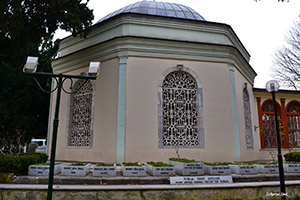The highest area in western Anatolia, Uludağ is easily ascended by car or cable-car. The park is about 22 km (14 mi) south of Bursa and is signposted from there. Bursa can be reached by road from Istanbul. The cable-car ascends from Bursa and has an intermediate stop in the alpine meadows of Kadiyayla at about 1,200 m (3,937 ft) elevation. It ends at Sarialan at about 1,630 m (5,348 ft).
Mt. Uludağ, the ancient Mysian Olympus, is one of the most popular skiing resorts in Turkey
Habitats of the park range from maquis on the lower slopes, through deciduous woodland and beech and fir forest to alpine meadows at the highest levels. It is a refuge for mountain birds, such as lammergeier and other vultures, golden eagle and more than 20 other raptor species. Other high-altitude species include alpine accentor, rock thrushes and choughs. The area is also good for eastern specialities such as isabelline wheatear, and, at almost the most westerly points of their range, red-fronted serin and Krüper’s nuthatch. The dense fir forest holds short-toed treecreeper, common crossbill and Tengmalm’s owl, a rare and very local bird in Turkey, as well as the white-backed woodpecker. The rare and local butterfly, Parnassius apollo graslini, is found on Uludag and the area has much of interest to botanists, with colourful pink primroses (Primula vulgaris var. sibthorpii), leopard’s bane (Doronicum orientale), crocuses: the purple Crocus siberi and yellow Crocus flavus, and grape hyacinths (Muscari racemosum). There are also few wolf packs roaming on the mountain.
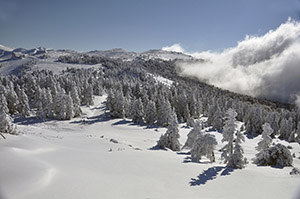
The Yeşil Mosque can be shown as the perfect blend between architecture and embellishment, the proof that such works of art were produced in a country where the battles between siblings had come to an end and peace had returned. It was commissioned by Sultan Mehmed I Çelebi and completed in December 1419 or January 1420. The mosque was built between 1419–1421 by architect vezir Hacı İvaz Pasha. The artists of painted decorations were Ali bin Ilyas and Mehmed el Mecnun. Following the 1855 Bursa earthquake, the building underwent an extensive renovation led by architect Léon Parvillée, as Ahmet Vefik Pasha, the Vali (governor) of Bursa, was unable to find a qualified Turkish architect. Parvillée managed to save the mosque but he lacked experience of the Seljukian and early Ottoman architecture. He was also hampered by shortages of money and skilled labour. The original decorations of the vaults and the walls were not restored. But his whitewash was perhaps to be preferred over botched attempts at reproducing old paintwork.
The architectural style known as Bursa Style begins with Green Mosque. The mosque is based on a reverse T-plan with a vestibule at the entrance leading to a central hall flanked by eyvans on the east and west and a larger eyvan with mihrab niche on the south. Two small eyvans flank the entryway above which the royal box (hünkar mahfili) is located. There are four rooms with fireplaces to the north and south of side eyvans accessed through the vestibule and the central hall respectively. Stairs on both sides of the vestibule lead to the upper floor where the royal lodge and two adjacent rooms for the royal women are located. Here, a passage opens to the balconies on the northern façade where the minaret steps begin. A portico was designed but never built, because, when the sultan died, work on his private mosque would stop.
The large entrance to the mosque is flanked by recessed marble sofas with twin cubby-holes (papuçluks) for the shoes. Above the door is a long Arabic inscription in bronze. The door is crowned by a half- dome with a cascade of mocárabe (stalactites) that taper into a star. The flat face of the half-dome, set in a ribbed frame, is adorned with arabesques and inscriptions in Rumi scripts. Between the inscription and the mocárabes is a small window that lights the floor of the foyer to the sultan’s box. Above the niches on each side of the entrance door is an inscription dedicated to Hacı İvaz, son of Ahi Beazit who designed the mosque. As Ahi Beazit was the prefect and later the governor of Bursa, it is not likely that he would have been the architect. But he would have concerned with overseeing the work. The builder would probably have relied on the teamwork and the craftsmanship of the Mason’s Guild to execute his plans.
Beneath the central dome, the sculpted white marble fountain within an octagonal pool adds to the beauty of the mosque. On one’s left and right side are two large eyvans (a vaulted recess open on one side).
The walls of the inner vestibule are covered with dark green tiles and, on each side, a great circle filled with blue, white and golden-yellow arabesques of tendrils and flowers.
The interior of the mosque is decorated with a mosaic of blue-green tiles on the walls and ceiling of the eyvans, from which it gets its name. (The exteriors with its domes, now clad with lead, were once also adorned with blue-green tiles in cuerda seca style).
One ascends from the vestibule to prayer hall via three steps. This stair is flanked on each side by three cubby-holes (papuçluk) for slippers. This shows the vestibule was paved and not carpeted as nowadays. Opposite stands the mihrab, the gate to paradise, with its moulded tile frame. Its niche is crowned by twelve rows of mocárabe, coming together in a six-ribbed shell on top. The intricate pattern of the tiles, full of flowers and entwining stems, was achieved through the cuerda seca technique, followed by ingenious gilding patterns.
Recessed on each side of the vestibule are mahfils (tribune for müezzins), richly decorated with tiles and whose ceilings are filled with complex roseate arabesques. The deep blue hexagonal wainscot tiles are somewhat less intricate, with traces of gold embedded. The two tabhane (lodging rooms for travellers) rooms, beyond the eyvans, contain niches and ocaks (fireplaces with a tall hood). A calligraphic inscription in three lines is put in an arch over one of its doors.
The northern eyvans, the royal lodge and the mihrab are embellished with tiles bearing polychromic flower motifs and scriptures in relief. There are many 19th century replacements among the tiles. There is also little left of the polychromic paintwork that used to embellish the rooms. The doors and window shutters are adorned with interlaced motifs carved on wood. Light reaches the dim interior through windows pierced into drums in the domes as well as through windows on exterior walls. An oculus above the ablution basin in the central hall was enclosed with a lantern at the time of restoration. A scripture in the mihrab area acknowledges “the work of Masters of Tabriz” on the tiles, and the name Nakkas Ali bin Ilyas Ali appears above the royal box as designer of the entire decorative scheme.
The mosque is built out of sandstone and clad with marble panels, a majority of which was replaced in the nineteenth century. Flower designs and scriptures carved in marble frame the entry and the windows, with a different design featured in tympana of every window. The grand entrance and the mihrab niches on the northern façade are crowned with marble mocárabe half-domes. The iron parts used on the door, windows and cupboards of the mosque are proof of excellent workmanship.
The two minarets are later additions to the building. They were both rebuilt on an old base by Parvillée. They have been fitted with stone spires carved in the baroque manner at the time of renovation. They can only be accessed through the sultan’s apartments and the climbing up the winding stairs to the attics.
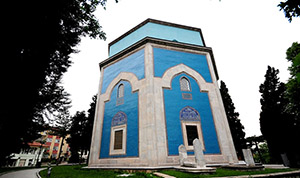
Ulu Cami is the largest mosque in Bursa and a landmark of early Ottoman architecture which used many elements from the Seljuk architecture. Ordered by Sultan Bayezid I, the mosque was designed and built by architect Ali Neccar in 1396–1399. It is a large rectangular building, with twenty domes arranged in four rows of five that are supported by twelve columns. Supposedly the twenty domes were built instead of the twenty separate mosques which Sultan Bayezid I had promised for winning the Battle of Nicopolis in 1396. The mosque has two minarets.
There is also a fountain (şadırvan) inside the mosque where worshipers can perform ritual ablutions before prayer; the dome over the şadırvan is capped by a skylight which creates a soft light below, playing an important role in the illumination of the large building.
The horizontally spacious and dimly lit interior is designed to feel peaceful and contemplative. The subdivisions of space formed by multiple domes and pillars create a sense of privacy and even intimacy.
Inside the mosque there are 192 monumental wall inscriptions written by the famous Ottoman calligraphers of that period. The mosque has one of the greatest examples of Islamic calligraphy in the world. The Calligraphy is written on the walls, columns and on small and large plates.
The mosque is located in the old city center of Bursa on the Atatürk Blvd.
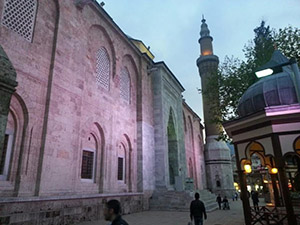
The Siege of Bursa (also called Prusa, Prousa, Brusa or Broussa) occurred from 1317/20 until the capture on 6 April 1326, when the Ottomans deployed a bold plan to seize Prusa (modern-day Bursa, Turkey). The Ottomans had not captured a city before; the lack of expertise and adequate siege equipment at this stage of the war meant that the city fell only after six or nine years. According to some sources Osman I died of natural causes just before the fall of the city, while others suggest that he lived long enough to hear about the victory on his death-bed and was buried in Bursa afterwards.
After the fall of the city, his son and successor Orhan made Bursa the first official Ottoman capital and it remained so until 1366, when Edirne became the new capital. As a result, Bursa holds a special place in Ottoman history as their founding city, and also as the birthplace of Ottoman architecture (Bursa Grand Mosque (1399), Bayezid I Mosque (1395), Hüdavendigar Mosque (1385), and Yeşil Mosque) (1421). During his reign Orhan encouraged urban growth through the construction of buildings such as imarets, Turkish baths, mosques, inns and caravanserais, and he also build a mosque and a medrese in what is now known as the Hisar district, and after his death was buried there in his türbe (mausoleum) next to his father. The Muslim traveler Ibn Battuta who visited Bursa in 1331 was impressed by the sultan and found Bursa an enjoyable city”with fine bazaars and wide streets, surrounded on all sides by gardens and running springs.”
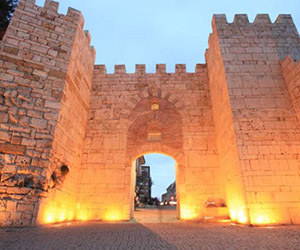
The bridge was commissioned by a wealthy merchant named Müslihidddin in 1442 during the reign of Murat II of the Ottoman Empire. Its architect was probably Architect Timurtaş. During the 1855 Bursa earthquake the bridge was partially damaged. During the Turkish War of Independence Bursa was occupied by the Greece. In 1922, the bridge was bombed by the retreating Greek army. It was closed to traffic. In 1949 the bridge was reconstructed by the municipality albeit with minor modifications. After 2004, following another restoration the bridge was opened to traffic.
The bridge is a single arc bridge. Arch span is 16 metres (52 ft) and the width is 11 metres (36 ft). It is an example of a rare type of covered bridge which houses a bazaar. ( It is claimed that there are only three other bridges in the World with shops on them which are Ponte Vecchio and Ponte Rialto in Italy and Osam Bridge in Bulgaria.) In the original design there were thirty shops on the bridge. According to Ass. Prof Önge during the Ottoman times, the bridge was also used to check traffic between two neighborhoods of Bursa by closing during the nights.
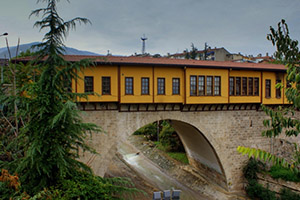
Pirinc Inn, Sultan II. It was built in 1508 by Bayezid to provide income for foundations in Istanbul. The architects of Pirinç Han are Yakup Shah bin Sultan Shah and Ali bin Abdullah. Ecebey bin Abdullah and Nadir Muhiddin. On the lower floor, there are 38 rooms on the upper floor. Today the lower floor cafe is used as a top floor empty.
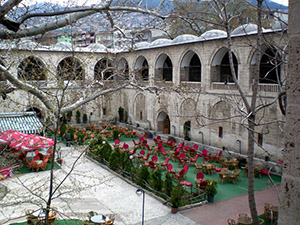
The large area betweem Ulucami and Orhan Mosque. In 1492 II. Bayezid was built to provide income for the mosque and madrasa in Istanbul. The architecture of the Inn is Abdul-ula bin Puladshah. It has two floors. There are 95 rooms on the top floor and 45 on the lower floor. The crown door in the north is made of large stone relief ornaments and has a magnificent appearance. On the upper floor there is a gate opening to the south, a wide door opening from the courtyard to the additional doors and a door opening to the Orhan Mosque side. There is a masjid in the center of the large courtyard inside the inn. Masjid is eight-sided, sitting on a foot at the corners and the middle. The lower part is fountain shaped. Today it is the center of the famous Bursa silk art.
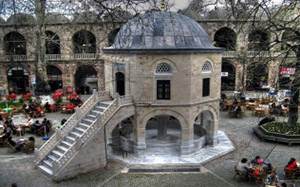
Emir Sultan, also known as Şemseddin Mehmed Ali el-Hüseyin el Buhari, was a dervish and scholar from Bukhara and also the advisor and son-in-law of the Ottoman Sultan Sultan, Bayezid I.
The present-day mosque, bearing his epithet Emir Sultan, and situated in Bursa quarter of the same name (although written contiguously, as “Emirsultan”), was built after the collapse of the original 14th-century monument in the 1766 earthquake. Although the materials and the location were maintained, the style was adjusted to reflect the baroque design that came into fashion in the Ottoman Empire during the 19th century. Following 1855 Bursa earthquake, the mosque and the mausoleum (Turkish: türbe) of Emir Sultan was rebuilt again in 1868 (1285 A.H) by Sultan Abdülaziz.
The mosque and mausoleum stand on opposite sides of a large courtyard with large basin at the entrance. The courtyard entrances are on the east and the west and the mosque and mausoleum are accessed through the courtyard. A wooden arcade with pointed arches wraps around the courtyard and rises to form portals with tall domes at bays leading into the buildings.
The mosque, on the south, is a tall single-unit prayer hall of masonry construction. There are two minarets at its corners on the north. The mausoleum, also on the south, is composed of a domed room in the center and smaller rooms to its sides and houses the tombs of Emir Sultan and his family. Other rooms on the north corner of the courtyard are for use by imams. An old cemetery covers the downside of the hill from the complex. Hundi Hatun, the wife of Emir Sultan and daughter of Bayezid I, built the hamam to the south of the mosque. There are numerous historic fountains scattered around the complex (külliye); the earliest dating from 1743.
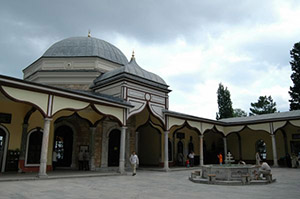
Golyazı is a Turkish town founded on a small peninsula on Lake Uluabat.
Golyazı was founded by the Ancient Greeks but remains of the Roman period are abundant.
Every year the town holds the Stork Festival and until the 20th century, Greeks and Manavlar lived together. In ancient times it was known as Apolloniatis The name Gölyazı means Fisherwoman
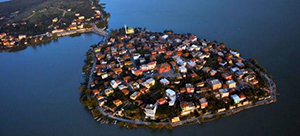
Tirilye is a town in Bursa Province, Mudanya, Turkey, situated 12 km (7.46 mi) west of Mudanya. It is a township along the Marmara Sea shoreline. The area, which was inhabited since the 5th century BC, was formerly known as Τρίγλεια, Trigleia or Βρύλλειον, Brylleion in Greek. When demand for the products of Southern Marmara from the ancient world increased, ports have been constructed in Kios (Gemlik), Kurşunlu, Apamea Myrlea(Mudanya), Siği (Kumyaka), and Trilye (Zeytinbağı) and the region boomed. The most important historical structure in Trilye(Triglia) is that of the Byzantine Haghioi Theodoroi Church, known today as the Fatih Mosque. Mudanya, a residential and commercial development in this township is under state protection as a historical site.
Trilye has been an important religious center for Greek Orthodox Christians for a long time. Trilye is a first level protected area since 1980 because of the Byzantine and Ottoman architectural monuments and is considered as an open-air museum thanks to the historical buildings and houses. Osman Gazi’s Turkmens in Bursa and surroundings have started settling in this location from the beginning of the year 1303. Kaymak Oba, Mirza Oba and Çepni villages located at the back of Trilye are believed to have been established during this era. After Mudanya was conquered in 1321 Trilye’s ports and other ports in the region started being used. The land at the western parts of Bursa namely the area between current Minor Industry Area (Küçük Sanayi Bölgesi) and Uluabat Lake were very fertile. Grapes, cocoons and cereal crops were grown in this region. In addition the Tahtalı, Demirci and Doğancı regions had high quality wood used in the production of ships. There are signs proving a Genoese cargo boat has visited Trilye port in the 1330s.
Churches and monasteries were constructed in Trigleia and its surroundings on the patronage of Byzantine Emperors.
Only 2500 people currently live in the town. In the town are the ruins of old Byzantine churches. Old Greek houses built at the end of the 19th century line what few streets are left. This town is under the protection by the Ministry of Culture so no one can destroy the old houses or rebuild them in a different style than the original one. The place is famous for its olives and had historically been inhabited by Greek artisans engaged in the silk trade. ‘Zeytingbagi’ means ‘olive yard’.
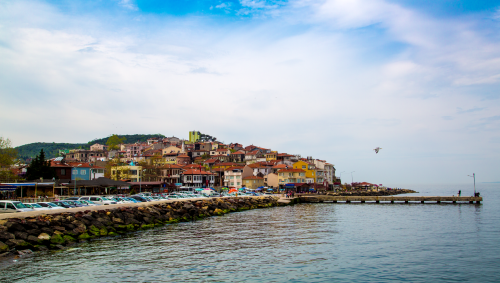
Cumalıkızık is a village in the Yıldırım district of Bursa Province, located 10 kilometers east of the city of Bursa, at the foot of Mount Uludağ. Its history goes back to the Ottoman Empire’s foundation period. The village is now included within the border of the Yıldırım district as a neighbourhood. Cumalıkızık was founded as a vakıf village. The historical texture of the village has been well protected and the civilian countryside architectural structures of the early Ottoman period are still intact. Because of this, Cumalıkızık has become a popular but still unspoiled center for tourists.
A group of similar villages which are placed close together between the foot of mount Uludağ and the valleys have been called Kızık in Turkish. The name stands for one of the twenty-four clans of the Oghuz Turks and the people from the villages also called Kızık. Similar villages, less well preserved, are Değirmenlikızık, Derekızık, and Hamamlıkızık (see Kızık for other places named Kızık in Turkey). Hamamlıkızık was the village of the local baths (hamam), and Cumalıkızık was named because people gathered there on Friday (Cuma, in Turkish) for worship.
The Cumalıkızık ethnography museum in the village’s square displays historical objects from the village. Every June there is a raspberry festival. The famous Cumalıkızık houses are made out of wood, adobe, rubblestones. Most of them are triplex houses. The windows upstairs are generally latticed and with a bay window. The handles and knockers on the main entry doors are made of wrought iron. Cobblestone streets are very narrow with no sidewalks, but a typical medieval gutter in the center for rain and waste water.
A mosque, the fountain of ‘Zekiye Hatun’ next to the mosque and a bath with one dome are original from the Ottoman Empire. Also there is a ruin of a church built by Byzantines.
Cumalıkızık holds 270 historical houses. Some of these houses are in process of restoration and maintenance, and 180 of them are still being used as dwellings.
In 1969, the remains of a Byzantine church were unearthed southeast of the village in the foothills of Mt. Uludağ. Some architectural works are on display in the Archeological Museum of Bursa. Movies and television programs with historical settings have often been recorded in Cumalıkızık.
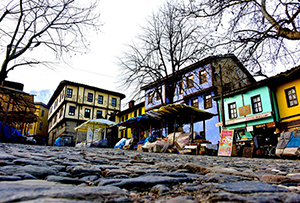
.gif)

